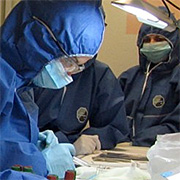 GMOSeralini.org press release: New website shows public lied to about GM maize study
GMOSeralini.org press release: New website shows public lied to about GM maize study
7 January 2013. Contact: Claire Robinson claire.robinson@gmoseralini.org
A new website set up by scientists and citizens challenges criticisms of a landmark study
The website, GMOSeralini.org, analyses the study by Prof Gilles-Eric Séralini’s team at the University of Caen, France, which found that rats fed GM maize and tiny amounts of the Roundup herbicide it is designed to be grown with suffered severe organ damage, increased tumours, and premature death. The website examines criticisms leveled at the study and finds that they do not stand up to scientific scrutiny.
Séralini’s study was the first to examine the effects of eating a commercialized GM maize and its associated pesticide over the long term. It was shouted down by a chorus of critics, who claimed it was flawed. But many of the critics were later exposed as having links with the GM industry or to be involved in GM crop approvals, so were not independent.[2]
Spokesperson for GMOSeralini.org Claire Robinson[3] said in the weeks following the publication of Séralini’s study she was contacted by scientists who were unhappy that science was being distorted to protect the GM industry.
Robinson said: “The consensus was that the public was lied to. The criticisms seemed designed to bury the research under a storm of insults, but they do not stand up to analysis.”
GMOSeralini.org systematically answers the criticisms. These included claims that Séralini used a tumour-prone rat and that the small number of rats in the study made it meaningless.
Robinson said: “Séralini used the same rat that Monsanto used in its 90-day study on the same GM maize and its long-term cancer studies on glyphosate, the main chemical in Roundup. And the number of rats was appropriate for a chronic toxicity study.
“Séralini’s study wasn’t a cancer study but a chronic toxicity study that happened to find tumours. Critics claim the tumours were due to chance, but the only way to prove that is by doing a full-scale long-term cancer study – something industry has avoided.”
Robinson said Séralini’s study was “political dynamite” because the longest studies that are normally done on GM foods are only 90 days long. Signs of kidney and liver toxicity appeared in Monsanto’s 90-day tests on the GM maize, but they were dismissed as not biologically meaningful by EFSA. Séralini designed his study to test this claim by extending the study length. He found that the initial signs of toxicity seen in the 90-day tests developed into severe organ damage over the longer two-year period, proving that EFSA’s claim was incorrect.
Also, the first tumours in Séralini’s study only showed up 4-7 months into the study, peaking at 18 months. The findings show that 90-day tests are too short to detect long-term effects like organ damage and cancer.
Robinson said: “The study shows that the way GM foods have been tested for safety since they were introduced is inadequate to protect people’s health.”
GMOSeralini.org has started a worldwide Avaaz petition calling for independent long-term safety tests to be carried out on all GM foods and their associated pesticides.
The website quotes statements of support from many scientists – challenging claims that the scientific community condemned the study.
Robinson said: “Séralini’s study isn’t perfect – no study is – but it is stronger in terms of design, study length, and health effects measured, than the industry studies that claim GM foods are safe.”
ENDS
1. Séralini GE, Clair E, Mesnage R, et al. Long term toxicity of a Roundup herbicide and a Roundup-tolerant genetically modified maize. Food and Chemical Toxicology. November 2012; 50(11): 4221-4231
2. Matthews J. Smelling a corporate rat. Spinwatch. 12 Dec 2012. The Guardian’s environment correspondent John Vidal called this article “The definitive analysis of the Séralini affair”. Available at http://www.spinwatch.org.uk/-articles-by-category-mainmenu-8/46-gm-industry/5546-smelling-a-corporate-rat
3. Claire Robinson is also an editor at GMWatch (GMWatch.org) and research director at Earth Open Source (earthopensource.org).
Notes





“But many of the critics were later exposed as having links with the GM industry or to be involved in GM crop approvals, so were not independent.”
This argument is a two-edged sword. The GM industry – notably Monsanto – is exporting advanced GM crop technology from North America to the competition elsewhere. This is costing North American exporters well over a billion dollars a year in outright competition, notably from South America, and lower global crop prices. It follows there is lots of cash from North America to fund anti-GM activism of the likes promoted by Robinson.
It is worth noting the Séralini study was published 19th September 2012, a day when Monsanto shares went up 2.9 percent, adding $1.4billion to the value of Monsanto. Half the Seralini experiment was nothing to do with GM crops: it attacked “Roundup”, a Monsanto-patented herbicide widely used for non-GM cropping. However, the Monsanto patent expired 10 years ago; glyphosate, the active ingredient in Roundup, is now made and exported mainly from China, and Monsanto probably has an in-patent substitute ready to replace Roundup. In defending Seralini Clair Robinson may be putting money into the pockets of Monsanto shareholders; Seralini certainly did. She is certainly in no position to criticise others for having links with the GM industry.
The major concern in the data of Séralini et al. 2012:
I think the main dispute on Séralini`s data concerns the question whether the findings are real or rather reflect fluctuations arising by chance.
As for many people statistics are rather difficult to understand, I propose an “experiment” everybody can perform. Just take a bag with seven white balls and three black balls. (Of course you may take any other subject that you cannot distinguish by eye, but not by touching.) The ten balls represent the Séralini`s control with the 10 untreated male rats as given in his Figure 1: The seven white balls are the male rats surviving the treatment, whereas the three black balls correspond to the rat that are either dead at the end of the experiments or had to be killed for ethical reasons due to the suffering from the tumours. To perform now your experiment, you take a ball from the bag and record whether it is white or black. After putting back the ball you repeat the random selection nine times. You now have your data for your control. You repeat this experiment to simulate the various treatments. In the following Table, I listed the outcome of my experiments and compared them to the data published by Séralini et al. 2012. As you can see, there is a lot of variation, ranging from 1 to 5 black balls corresponding to the dead male rats. It illustrates how the outcome of an experiment can differ just by chance. You will see that the values in your experiments will lie in a similar range, but distributed quite differently to the various “treatments”. But of course you know that you did not change the “treatments” in your experiments.
Cause of death: Data for males taken from Figure 1
Dead males in 10 males at the end of the experiment
Treatment data my game of dice)
0 (none) 3 3
11 GMO 5 2
22 GMO 1 2
33 GMO 1 4
11 GMO+R 4 2
22 GMO+R 5 5
33 GMO+R 3 3
A R 3 1
B R 4 4
C R 1 2
You may now realize that the conclusions of the paper are quite questionable.
Instead of using such a game of dice there are statistical methods to evaluate mortality rates. In fact, using Séralini`s data the Chi-square test failed to show any statistical significant differences(Ollivier,L. (2012). A Comment on “Seralini, G.-E., et al., Long term toxicity of a Roundup herbicide and a Roundup-tolerant genetically modified maize. Food Chem. Toxicol. (2012),” http://dx.doi.org/10.1016/j.fct.2012.08.005).
The major concern in the data of Séralini et al. 2012:
I think the main dispute on Séralini`s data concerns the question whether the findings are real or rather reflect fluctuations arising by chance.
As for many people statistics are rather difficult to understand, I propose an “experiment” everybody can perform. Just take a bag with seven white balls and three black balls. (Of course you may take any other subject that you cannot distinguish by eye, but not by touching.) The ten balls represent the Séralini`s control with the 10 untreated male rats as given in his Figure 1: The seven white balls are the male rats surviving the treatment, whereas the three black balls correspond to the rat that are either dead at the end of the experiments or had to be killed for ethical reasons due to the suffering from the tumours. To perform now your experiment, you take a ball from the bag and record whether it is white or black. After putting back the ball you repeat the random selection nine times. You now have your data for your control. You repeat this experiment to simulate the various treatments. In the following Table, I listed the outcome of my experiments and compared them to the data published by Séralini et al. 2012. As you can see, there is a lot of variation, ranging from 1 to 5 black balls corresponding to the dead male rats. It illustrates how the outcome of an experiment can differ just by chance. You will see that the values in your experiments will lie in a similar range, but distributed quite differently to the various “treatments”. But of course you know that you did not change the “treatments” in your experiments.
Cause of death: Data for males taken from Figure 1
Dead males in 10 males at the end of the experiment
Treatment data my game of dice)
0 (none) 3 3
11 GMO 5 2
22 GMO 1 2
33 GMO 1 4
11 GMO+R 4 2
22 GMO+R 5 5
33 GMO+R 3 3
A R 3 1
B R 4 4
C R 1 2
You may now realize that the conclusions of the paper are quite questionable.
Instead of using such a game of dice there are statistical methods to evaluate mortality rates. In fact, using Séralini`s data the Chi-square test failed to show any statistical significant differences(Oll ivier,L. (2012). A Comment on “Seralini, G.-E., et al., Long term toxicity of a Roundup herbicide and a Roundup-toleran t genetically modified maize. Food Chem. Toxicol. (2012),” http://dx.doi.org/10.1016/j.fct.2012.08.005).
Gerhart, Think the problem may be that you are trying to fit a square peg into a round hole in doing a stat analysis on a finding for which there are not enough animals. Seralini et al didn’t do stat analysis on the mortality or tumours because there were not enough animals for this. He did do stat analysis on the organ damage because there were enough animals for this (chronic tox standard design). However, there was a trend of treatment groups getting more tumours earlier and those tumours growing quicker; there was also a trend of increased mortality rates. These two findings would have to be confirmed as stat. signif. in a full-scale carcinogenicity study with larger numbers of animals, which Monsanto would have to fund. See gmoseralini.org for more information.
Peter, o.k. we would agree that there were not enough animals to do a statistical analysis.
However, Seralini`s papers says in the abstract: “In females, all treated groups died 2–3 times more than controls, and more rapidly. This difference was visible in 3 male groups fed GMOs”.
Such a statement cannot be made, if a finding is just random. The scientific conclusion would be: There is no effect on mortality.
You argue there is a trend, but there is no trend if a finding is random. With your attitude someone could argue there is a trend to reduce mortality by feeding 22% and 33% GMO in male rats (see Figure 1). He would go on and claim GMO is potentially protective against cancer and this has to be verified by the use of more animals. I guess this example illustrates that no effect is no effect and trends are wishful thinking.
Gerhart, there were enough animals to do stat analysis on the organ damage, which alone was an alarming finding. It is by no means proven that the findings are random as you suggest and the findings should be examined as a whole, as a collection of effects together. When seen in this way rather than in isolation, there is clearly a trend of toxic effects from the treatments which should not be just swept away.
It’s worth noting that it’s common for chronic tox experiments NOT to have enough animals for stat analysis on certain findings. It doesn’t mean you can just wish away the findings. Now that is wishful thinking!
Please advise the location of the avazz petition
Avaaz petition is here
http://www.avaaz.org/en/petition/Freeze_GM_food_approvals_now/?wetoqab